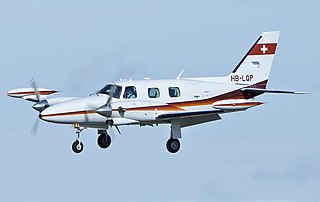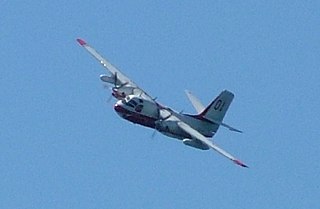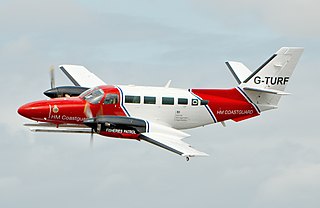
The Pratt & Whitney Canada PT6 is a turboprop aircraft engine produced by Pratt & Whitney Canada. Its design was started in 1958, it first ran in February 1960, first flew on 30 May 1961, entered service in 1964, and has been continuously updated since. The PT6 consists of two basic sections: a gas generator with accessory gearbox, and a free-power turbine with reduction gearbox. In aircraft, the engine is often mounted "backwards," with the intake at the rear and the exhaust at the front, so that the turbine is directly connected to the propeller. Many variants of the PT6 have been produced, not only as turboprops but also as turboshaft engines for helicopters, land vehicles, hovercraft, and boats; as auxiliary power units; and for industrial uses. By November 2015, 51,000 had been produced, which had logged 400 million flight hours from 1963 to 2016. It is known for its reliability, with an in-flight shutdown rate of 1 per 651,126 hours in 2016. The PT6A turboprop engine covers the power range between 580 and 1,940 shp, while the PT6B/C are turboshaft variants for helicopters.

The Beechcraft King Air is a line of American utility aircraft produced by Beechcraft. The King Air line comprises a number of twin-turboprop models that have been divided into two families. The Model 90 and 100 series developed in the 1960s are known as King Airs, while the later T-tail Model 200 and 300 series were originally marketed as Super King Airs, with the name "Super" being dropped by Beechcraft in 1996.

The Pilatus PC-6 Porter is a single-engined STOL utility aircraft designed by Pilatus Aircraft of Switzerland. First flown in 1959, the PC-6 was produced at Pilatus Flugzeugwerke in Stans, Switzerland. It has been built in both piston engine- and turboprop-powered versions, and was produced under licence for a time by Fairchild Hiller in the United States. After 604 deliveries in 63 years, Pilatus ended production in 2022.

The Beechcraft T-34 Mentor is an American propeller-driven, single-engined, military trainer aircraft derived from the Beechcraft Model 35 Bonanza. The earlier versions of the T-34, dating from around the late 1940s to the 1950s, were piston-engined. These were eventually succeeded by the upgraded T-34C Turbo-Mentor, powered by a turboprop engine. The T-34 remains in service more than seven decades after it was first designed.

The Ayres Thrush, formerly the Snow S-2, Aero Commander Ag Commander, and Rockwell Thrush Commander, is an American agricultural aircraft produced by Ayres Corporation and more recently by Thrush Aircraft. It is one of the most successful and long-lived agricultural application aircraft types in the world, with almost 2,000 sold since the first example flew 68 years ago. Typical of agricultural aircraft, it is a single-seat monoplane of conventional taildragger configuration. Originally powered by a radial piston engine, most examples produced since the 1980s have been turboprop-powered.

The Beechcraft 60 Duke is an American-built twin-engine fixed-wing aircraft designed and produced by Beechcraft. The aircraft has retractable tricycle landing gear and a pressurized cabin. The two piston engines are turbocharged and the turbochargers also pressurize the cabin with bleed air.

The Embraer EMB 121 Xingu is a twin-turboprop fixed-wing aircraft built by the Brazilian aircraft manufacturer, Embraer. The design is based on the EMB 110 Bandeirante, using its wing and engine design merged with an all-new fuselage. The EMB 121 first flew on 10 October 1976.

The Beechcraft Model 18 is a 6- to 11-seat, twin-engined, low-wing, tailwheel light aircraft manufactured by the Beech Aircraft Corporation of Wichita, Kansas. Continuously produced from 1937 to November 1969, over 9,000 were built, making it one of the world's most widely used light aircraft. Sold worldwide as a civilian executive, utility, cargo aircraft, and passenger airliner on tailwheels, nosewheels, skis, or floats, it was also used as a military aircraft.

The Beechcraft 1900 is a twin-engine turboprop regional airliner manufactured by Beechcraft. It is also used as a freight aircraft and corporate transport, and by several governmental and military organizations. With customers favoring larger regional jets, Raytheon ended production in October 2002.

The PZL 130 Orlik is a Polish turboprop, single engine, two seat trainer aircraft.

The Piper PA-31T Cheyenne is a turboprop development of the earlier PA-31P Pressurized Navajo.

The Cessna 421 Golden Eagle is an American six or seven seat twin-engined light transport aircraft, developed in the 1960s by Cessna as a pressurized version of the earlier Cessna 411.

The Beechcraft Model 99 is a civilian aircraft produced by Beechcraft. It is also known as the Beech 99 Airliner and the Commuter 99. The 99 is a twin-engine, unpressurized, 15 to 17 passenger seat turboprop aircraft, derived from the earlier Beechcraft King Air and Queen Air. It uses the wings of the Queen Air, the engines and nacelles of the King Air, and sub-systems from both, with a specifically designed nose structure.

The Honeywell TPE331 is a turboprop engine. It was designed in the 1950s by Garrett AiResearch, and produced since 1999 by successor Honeywell Aerospace. The engine's power output ranges from 575 to 1,650 shaft horsepower.

The Conair Firecat is a fire-fighting aircraft developed in Canada in the 1970s by modifying military surplus Grumman S-2 Trackers. The modifications were developed by the maintenance arm of the Conair Group, which became a separate company called Cascade Aerospace.

The Reims-Cessna F406 Caravan II is a turboprop twin engine utility aircraft manufactured and designed by Reims Aviation in cooperation with Cessna.
The Scaled Composites Model 133-4.62 ATTT, or Advanced Technology Tactical Transport was a technology demonstration project built by Burt Rutan's Scaled Composites in 1986 under contract to DARPA.

The Swearingen Merlin or the Fairchild Aerospace Merlin is a pressurized, twin turboprop business aircraft first produced by Swearingen Aircraft, and later by Fairchild at a plant in San Antonio, Texas.

The Gulfstream American Hustler was a 1970s American mixed-power executive/utility aircraft designed by American Jet Industries, which later changed to Gulfstream American Corporation. The aircraft had a nose-mounted turboprop and a tail-mounted turbofan.
The Smith X-99 Prop-Jet was a six-seat turboprop powered business aircraft designed in the United States in the 1980s. Only one was built.

















